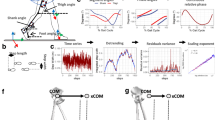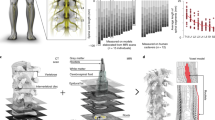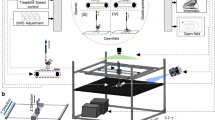Abstract
Electrical neuromodulation of lumbar segments improves motor control after spinal cord injury in animal models and humans. However, the physiological principles underlying the effect of this intervention remain poorly understood, which has limited the therapeutic approach to continuous stimulation applied to restricted spinal cord locations. Here we developed stimulation protocols that reproduce the natural dynamics of motoneuron activation during locomotion. For this, we computed the spatiotemporal activation pattern of muscle synergies during locomotion in healthy rats. Computer simulations identified optimal electrode locations to target each synergy through the recruitment of proprioceptive feedback circuits. This framework steered the design of spatially selective spinal implants and real-time control software that modulate extensor and flexor synergies with precise temporal resolution. Spatiotemporal neuromodulation therapies improved gait quality, weight-bearing capacity, endurance and skilled locomotion in several rodent models of spinal cord injury. These new concepts are directly translatable to strategies to improve motor control in humans.
This is a preview of subscription content, access via your institution
Access options
Subscribe to this journal
Receive 12 print issues and online access
$209.00 per year
only $17.42 per issue
Buy this article
- Purchase on Springer Link
- Instant access to full article PDF
Prices may be subject to local taxes which are calculated during checkout






Similar content being viewed by others
References
Borton, D., Micera, S., Millán, Jdel.R. & Courtine, G. Personalized neuroprosthetics. Sci. Transl. Med. 5, 210rv2 (2013).
Lozano, A.M. & Lipsman, N. Probing and regulating dysfunctional circuits using deep brain stimulation. Neuron 77, 406–424 (2013).
Barthélemy, D., Leblond, H. & Rossignol, S. Characteristics and mechanisms of locomotion induced by intraspinal microstimulation and dorsal root stimulation in spinal cats. J. Neurophysiol. 97, 1986–2000 (2007).
Courtine, G. et al. Transformation of nonfunctional spinal circuits into functional states after the loss of brain input. Nat. Neurosci. 12, 1333–1342 (2009).
van den Brand, R. et al. Restoring voluntary control of locomotion after paralyzing spinal cord injury. Science 336, 1182–1185 (2012).
Holinski, B.J., Everaert, D.G., Mushahwar, V.K. & Stein, R.B. Real-time control of walking using recordings from dorsal root ganglia. J. Neural Eng. 10, 056008 (2013).
Wenger, N. et al. Closed-loop neuromodulation of spinal sensorimotor circuits controls refined locomotion after complete spinal cord injury. Sci. Transl. Med. 6, 255ra133 (2014).
Carhart, M.R., He, J., Herman, R., D'Luzansky, S. & Willis, W.T. Epidural spinal–cord stimulation facilitates recovery of functional walking following incomplete spinal–cord injury. IEEE Trans. Neural Syst. Rehabil. Eng. 12, 32–42 (2004).
Angeli, C.A., Edgerton, V.R., Gerasimenko, Y.P. & Harkema, S.J. Altering spinal cord excitability enables voluntary movements after chronic complete paralysis in humans. Brain 137, 1394–1409 (2014).
Gerasimenko, Y.P. et al. Noninvasive reactivation of motor descending control after paralysis. J. Neurotrauma 32, 1968–1980 (2015).
Herman, R., He, J., D'Luzansky, S., Willis, W. & Dilli, S. Spinal cord stimulation facilitates functional walking in a chronic, incomplete spinal cord injured. Spinal Cord 40, 65–68 (2002).
Capogrosso, M. et al. A computational model for epidural electrical stimulation of spinal sensorimotor circuits. J. Neurosci. 33, 19326–19340 (2013).
Rattay, F., Minassian, K. & Dimitrijevic, M.R. Epidural electrical stimulation of posterior structures of the human lumbosacral cord: 2. Quantitative analysis by computer modeling. Spinal Cord 38, 473–489 (2000).
Ladenbauer, J., Minassian, K., Hofstoetter, U.S., Dimitrijevic, M.R. & Rattay, F. Stimulation of the human lumbar spinal cord with implanted and surface electrodes: a computer simulation study. IEEE Trans. Neural Syst. Rehabil. Eng. 18, 637–645 (2010).
Hofstoetter, U.S. et al. Periodic modulation of repetitively elicited monosynaptic reflexes of the human lumbosacral spinal cord. J. Neurophysiol. 114, 400–410 (2015).
Gerasimenko, Y.P. et al. Spinal cord reflexes induced by epidural spinal cord stimulation in normal awake rats. J. Neurosci. Methods 157, 253–263 (2006).
Sayenko, D.G., Angeli, C.A., Harkema, S.J., Edgerton, V.R. & Gerasimenko, Y.P. Neuromodulation of evoked muscle potentials induced by epidural spinal cord stimulation in paralyzed individuals. J. Neurophysiol. 111, 1088–1099 (2014).
Danner, S.M. et al. Human spinal locomotor control is based on flexibly organized burst generators. Brain 138, 577–588 (2015).
Edgerton, V.R. et al. Training locomotor networks. Brain Res. Rev. 57, 241–254 (2008).
Rejc, E., Angeli, C. & Harkema, S. Effects of lumbosacral spinal cord epidural stimulation for standing after chronic complete paralysis in humans. PLoS ONE 10, e0133998 (2015).
Yakovenko, S., Mushahwar, V., VanderHorst, V., Holstege, G. & Prochazka, A. Spatiotemporal activation of lumbosacral motoneurons in the locomotor step cycle. J. Neurophysiol. 87, 1542–1553 (2002).
Cappellini, G., Ivanenko, Y.P., Dominici, N., Poppele, R.E. & Lacquaniti, F. Migration of motor pool activity in the spinal cord reflects body mechanics in human locomotion. J. Neurophysiol. 104, 3064–3073 (2010).
Ivanenko, Y.P. et al. Temporal components of the motor patterns expressed by the human spinal cord reflect foot kinematics. J. Neurophysiol. 90, 3555–3565 (2003).
Dominici, N. et al. Locomotor primitives in newborn babies and their development. Science 334, 997–999 (2011).
Kiehn, O. Locomotor circuits in the mammalian spinal cord. Annu. Rev. Neurosci. 29, 279–306 (2006).
Berniker, M., Jarc, A., Bizzi, E. & Tresch, M.C. Simplified and effective motor control based on muscle synergies to exploit musculoskeletal dynamics. Proc. Natl. Acad. Sci. USA 106, 7601–7606 (2009).
Lee, D.D. & Seung, H.S. Learning the parts of objects by non-negative matrix factorization. Nature 401, 788–791 (1999).
Lavrov, I. et al. Epidural stimulation induced modulation of spinal locomotor networks in adult spinal rats. J. Neurosci. 28, 6022–6029 (2008).
Minassian, K. et al. Stepping-like movements in humans with complete spinal cord injury induced by epidural stimulation of the lumbar cord: electromyographic study of compound muscle action potentials. Spinal Cord 42, 401–416 (2004).
Ichiyama, R.M. et al. Step training reinforces specific spinal locomotor circuitry in adult spinal rats. J. Neurosci. 28, 7370–7375 (2008).
Gad, P. et al. Forelimb EMG-based trigger to control an electronic spinal bridge to enable hindlimb stepping after a complete spinal cord lesion in rats. J. Neuroeng. Rehabil. 9, 38 (2012).
Consortium for Addressing Paralysis through Spinal Stimulation Technologies. Framework for a Research Study on Epidural Spinal Stimulation to Improve Bladder, Bowel, and Sexual Function in Individuals with Spinal Cord Injuries. (National Institutes of Health, 2015).
Bizzi, E., Tresch, M.C., Saltiel, P. & d'Avella, A. New perspectives on spinal motor systems. Nat. Rev. Neurosci. 1, 101–108 (2000).
Bernstein, N. The Co-ordination and Regulation of Movements (Pergamon, 1967).
Giszter, S.F. Motor primitives—new data and future questions. Curr. Opin. Neurobiol. 33, 156–165 (2015).
La Scaleia, V., Ivanenko, Y.P., Zelik, K.E. & Lacquaniti, F. Spinal motor outputs during step-to-step transitions of diverse human gaits. Front. Hum. Neurosci. 8, 305 (2014).
Hägglund, M. et al. Optogenetic dissection reveals multiple rhythmogenic modules underlying locomotion. Proc. Natl. Acad. Sci. USA 110, 11589–11594 (2013).
Levine, A.J. et al. Identification of a cellular node for motor control pathways. Nat. Neurosci. 17, 586–593 (2014).
Tripodi, M., Stepien, A.E. & Arber, S. Motor antagonism exposed by spatial segregation and timing of neurogenesis. Nature 479, 61–66 (2011).
Grillner, S. & Jessell, T.M. Measured motion: searching for simplicity in spinal locomotor networks. Curr. Opin. Neurobiol. 19, 572–586 (2009).
Arber, S. Motor circuits in action: specification, connectivity, and function. Neuron 74, 975–989 (2012).
Bourane, S. et al. Identification of a spinal circuit for light touch and fine motor control. Cell 160, 503–515 (2015).
Hart, C.B. & Giszter, S.F. A neural basis for motor primitives in the spinal cord. J. Neurosci. 30, 1322–1336 (2010).
Kargo, W.J., Ramakrishnan, A., Hart, C.B., Rome, L.C. & Giszter, S.F. A simple experimentally based model using proprioceptive regulation of motor primitives captures adjusted trajectory formation in spinal frogs. J. Neurophysiol. 103, 573–590 (2010).
Sayenko, D.G., Angeli, C., Harkema, S.J., Edgerton, V.R. & Gerasimenko, Y.P. Neuromodulation of evoked muscle potentials induced by epidural spinal-cord stimulation in paralyzed individuals. J. Neurophysiol. 111, 1088–1099 (2014).
Zeng, F.G., Rebscher, S., Harrison, W., Sun, X. & Feng, H. Cochlear implants: system design, integration, and evaluation. IEEE Rev. Biomed. Eng. 1, 115–142 (2008).
Capaday, C. The special nature of human walking and its neural control. Trends Neurosci. 25, 370–376 (2002).
Clarac, F., Cattaert, D. & Le Ray, D. Central control components of a 'simple' stretch reflex. Trends Neurosci. 23, 199–208 (2000).
Canbay, S. et al. Anatomical relationship and positions of the lumbar and sacral segments of the spinal cord according to the vertebral bodies and the spinal roots. Clin. Anat. 27, 227–233 (2014).
Mariani, B., Jiménez, M.C., Vingerhoets, F.J. & Aminian, K. On-shoe wearable sensors for gait and turning assessment of patients with Parkinson's disease. IEEE Trans. Biomed. Eng. 60, 155–158 (2013).
Afshar, P. et al. A translational platform for prototyping closed-loop neuromodulation systems. Front. Neural Circuits 6, 117 (2012).
Minev, I.R. et al. Biomaterials. Electronic dura mater for long-term multimodal neural interfaces. Science 347, 159–163 (2015).
Dominici, N. et al. Versatile robotic interface to evaluate, enable and train locomotion and balance after neuromotor disorders. Nat. Med. 18, 1142–1147 (2012).
Stieglitz, T. & Meyer, J.U. Implantable microsystems. Polyimide-based neuroprostheses for interfacing nerves. Med. Device Technol. 10, 28–30 (1999).
Acknowledgements
We thank people who have helped over the past 6 years to take care of injured animals and to test multiple iterations of neural implants. We also would like to thank D. Pioletti for providing access to the microcomputed tomography scanner. N.W. is a participant in the Charité Clinical Scientist Program funded by the Charité–Universitätsmedizin Berlin and the Berlin Institute of Health. Funding was provided by the European Commission's Seventh Framework Programme (CP-IP 258654, NeuWALK, G.C., S.M., E.B., J.B. and P.D.); a Starting Grant from the European Research Council (ERC 261247, Walk Again, G.C.); the Russian Science Foundation (RSF grant 14-15-00788, P.M.) and the Swiss National Science Foundation Centre of Competence in Research (NCCR) in Robotics (G.C., S.L., S.M.), Dynamo project (S.M.) and NanoTera.ch program (SpineRepair) (G.C., S.L. and S.M.).
Author information
Authors and Affiliations
Contributions
P.M. and M.C. contributed equally as second authors to this work. N.W., P.M., J.B., N.P. and G.C. developed and performed the surgeries. N.W., E.M.M., J.G., P.M., J.D., L.B., S.D., M.C., L.A. and G.C. performed in vivo experiments. N.W., E.M.M., J.G., C.G.L.G., L.A., N.D. and G.C. analyzed functional data. N.W., E.M.M. and J.G. conducted the statistical analysis. S.P.L., P.D., I.R.M., A.H., P.M., O.H., S.K. and F.S. developed the implant technology. M.C., A.M. and S.M. conducted computational simulations. J.K., Q.B. and N.P. conducted anatomical evaluations. N.W., E.M.M., P.M., M.C., J.D., S.M., E.B. and G.C. conceived experiments. R.v.d.B., E.B., J.B., L.B. and S.D. were responsible for the animal models. N.W., E.M.M., L.A., J.G., C.G.L.G., and G.C. prepared the figures with the help of the other authors. G.C. wrote the manuscript, and all authors contributed to its editing. G.C. supervised and coordinated all the aspects of the work.
Corresponding author
Ethics declarations
Competing interests
G.C., N.W., P.M., M.C., L.A., J.B., I.R.M., E.M.M., S.M. and S.P.L. hold various patents on electrode implant designs (WO2011/157714), chemical neuromodulation therapies (WO2015/000800), spatiotemporal neuromodulation algorithms (WO2015/063127), and robot-assisted rehabilitation enabled by neuromodulation therapies (WO2013/179230). G.C., S.L., S.M. and J.B. are founders and shareholders of G-Therapeutics SA, a company developing neuroprosthetic systems in direct relationship with the present work.
Supplementary information
Supplementary Text and Figures
Supplementary Figures 1–11 and Supplementary Tables 1–2 (PDF 11392 kb)
Tailored spinal implant to achieve spatial selectivity.
This movie illustrates the spatial distribution of hindlimb motoneurons, the design of spatially selective spinal implant targeting specific subsets of dorsal roots, and the ability of stimulation delivered through this implant to elicit limb and direction specific motor responses (MP4 23363 kb)
Spatiotemporal neuromodulation therapies after complete SCI.
This movie shows the reconstructed spatiotemporal map of motoneuron activation during locomotion in intact rats, the online monitoring system, the complete SCI model, the ability of spatiotemporal neuromodulation to reproduce natural motoneuron activation dynamics during locomotion, and the tuning of extension versus flexion hotspots with increase in stimulation amplitude. (MP4 25020 kb)
Spatiotemporal neuromodulation improves motor control after clinically relevant SCI.
This movie shows the anatomical impact of the contusion SCI, the ability of spatiotemporal neuromodulation to enable robust locomotion early after the injury, and the ability of spatiotemporal neuromodulation to enable locomotion overground and along a staircase in the chronic stage of the SCI. (MP4 27666 kb)
Rights and permissions
About this article
Cite this article
Wenger, N., Moraud, E., Gandar, J. et al. Spatiotemporal neuromodulation therapies engaging muscle synergies improve motor control after spinal cord injury. Nat Med 22, 138–145 (2016). https://doi.org/10.1038/nm.4025
Received:
Accepted:
Published:
Issue Date:
DOI: https://doi.org/10.1038/nm.4025
This article is cited by
-
Functional plasticity of glutamatergic neurons of medullary reticular nuclei after spinal cord injury in mice
Nature Communications (2024)
-
Dual electrical stimulation at spinal-muscular interface reconstructs spinal sensorimotor circuits after spinal cord injury
Nature Communications (2024)
-
Beyond treatment of chronic pain: a scoping review about epidural electrical spinal cord stimulation to restore sensorimotor and autonomic function after spinal cord injury
Neurological Research and Practice (2023)
-
Longitudinal interrogation of sympathetic neural circuits and hemodynamics in preclinical models
Nature Protocols (2023)
-
Neuroprosthetics: from sensorimotor to cognitive disorders
Communications Biology (2023)



